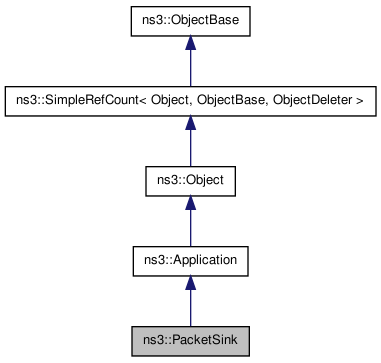Receive and consume traffic generated to an IP address and port. More...
#include <packet-sink.h>


Public Member Functions | |
| uint32_t | GetTotalRx () const |
Static Public Member Functions | |
| static TypeId | GetTypeId (void) |
| This method returns the TypeId associated to ns3::PacketSink. | |
Protected Member Functions | |
| virtual void | DoDispose (void) |
Detailed Description
Receive and consume traffic generated to an IP address and port.
This application was written to complement OnOffApplication, but it is more general so a PacketSink name was selected. Functionally it is important to use in multicast situations, so that reception of the layer-2 multicast frames of interest are enabled, but it is also useful for unicast as an example of how you can write something simple to receive packets at the application layer. Also, if an IP stack generates ICMP Port Unreachable errors, receiving applications will be needed.
The constructor specifies the Address (IP address and port) and the transport protocol to use. A virtual Receive () method is installed as a callback on the receiving socket. By default, when logging is enabled, it prints out the size of packets and their address, but we intend to also add a tracing source to Receive() at a later date.
Member Function Documentation
| virtual void ns3::PacketSink::DoDispose | ( | void | ) | [protected, virtual] |
This method is called by Object::Dispose or by the object's destructor, whichever comes first.
Subclasses are expected to implement their real destruction code in an overriden version of this method and chain up to their parent's implementation once they are done. i.e., for simplicity, the destructor of every subclass should be empty and its content should be moved to the associated DoDispose method.
It is safe to call GetObject from within this method.
Reimplemented from ns3::Application.
| uint32_t ns3::PacketSink::GetTotalRx | ( | ) | const |
- Returns:
- the total bytes received in this sink app
| static TypeId ns3::PacketSink::GetTypeId | ( | void | ) | [static] |
This method returns the TypeId associated to ns3::PacketSink.
This object is accessible through the following paths with Config::Set and Config::Connect:
- /NodeList/[i]/ApplicationList/[i]/$ns3::PacketSink
- /NodeList/[i]/DeviceList/[i]/$ns3::AlohaNoackNetDevice/Phy/$ns3::Application/$ns3::PacketSink
- /NodeList/[i]/DeviceList/[i]/$ns3::AlohaNoackNetDevice/Phy/$ns3::PacketSink
- /NodeList/[i]/DeviceList/[i]/$ns3::BaseStationNetDevice/BsIpcsPacketClassifier/$ns3::Application/$ns3::PacketSink
- /NodeList/[i]/DeviceList/[i]/$ns3::BaseStationNetDevice/BsIpcsPacketClassifier/$ns3::PacketSink
- /NodeList/[i]/DeviceList/[i]/$ns3::BaseStationNetDevice/LinkManager/$ns3::Application/$ns3::PacketSink
- /NodeList/[i]/DeviceList/[i]/$ns3::BaseStationNetDevice/LinkManager/$ns3::PacketSink
- /NodeList/[i]/DeviceList/[i]/$ns3::BaseStationNetDevice/SSManager/$ns3::Application/$ns3::PacketSink
- /NodeList/[i]/DeviceList/[i]/$ns3::BaseStationNetDevice/SSManager/$ns3::PacketSink
- /NodeList/[i]/DeviceList/[i]/$ns3::BaseStationNetDevice/ServiceFlowManager/$ns3::Application/$ns3::PacketSink
- /NodeList/[i]/DeviceList/[i]/$ns3::BaseStationNetDevice/ServiceFlowManager/$ns3::PacketSink
- /NodeList/[i]/DeviceList/[i]/$ns3::NonCommunicatingNetDevice/Phy/$ns3::Application/$ns3::PacketSink
- /NodeList/[i]/DeviceList/[i]/$ns3::NonCommunicatingNetDevice/Phy/$ns3::PacketSink
- /NodeList/[i]/DeviceList/[i]/$ns3::SubscriberStationNetDevice/Classifier/$ns3::Application/$ns3::PacketSink
- /NodeList/[i]/DeviceList/[i]/$ns3::SubscriberStationNetDevice/Classifier/$ns3::PacketSink
- /NodeList/[i]/DeviceList/[i]/$ns3::SubscriberStationNetDevice/LinkManager/$ns3::Application/$ns3::PacketSink
- /NodeList/[i]/DeviceList/[i]/$ns3::SubscriberStationNetDevice/LinkManager/$ns3::PacketSink
- /NodeList/[i]/DeviceList/[i]/$ns3::SubscriberStationNetDevice/SSScheduler/$ns3::Application/$ns3::PacketSink
- /NodeList/[i]/DeviceList/[i]/$ns3::SubscriberStationNetDevice/SSScheduler/$ns3::PacketSink
- /NodeList/[i]/DeviceList/[i]/$ns3::UanNetDevice/Channel/NoiseModel/$ns3::Application/$ns3::PacketSink
- /NodeList/[i]/DeviceList/[i]/$ns3::UanNetDevice/Channel/NoiseModel/$ns3::PacketSink
- /NodeList/[i]/DeviceList/[i]/$ns3::UanNetDevice/Channel/PropagationModel/$ns3::Application/$ns3::PacketSink
- /NodeList/[i]/DeviceList/[i]/$ns3::UanNetDevice/Channel/PropagationModel/$ns3::PacketSink
- /NodeList/[i]/DeviceList/[i]/$ns3::UanNetDevice/Mac/$ns3::Application/$ns3::PacketSink
- /NodeList/[i]/DeviceList/[i]/$ns3::UanNetDevice/Mac/$ns3::PacketSink
- /NodeList/[i]/DeviceList/[i]/$ns3::UanNetDevice/Phy/$ns3::Application/$ns3::PacketSink
- /NodeList/[i]/DeviceList/[i]/$ns3::UanNetDevice/Phy/$ns3::PacketSink
- /NodeList/[i]/DeviceList/[i]/$ns3::UanNetDevice/Transducer/$ns3::Application/$ns3::PacketSink
- /NodeList/[i]/DeviceList/[i]/$ns3::UanNetDevice/Transducer/$ns3::PacketSink
- /NodeList/[i]/DeviceList/[i]/$ns3::WimaxNetDevice/$ns3::BaseStationNetDevice/BsIpcsPacketClassifier/$ns3::Application/$ns3::PacketSink
- /NodeList/[i]/DeviceList/[i]/$ns3::WimaxNetDevice/$ns3::BaseStationNetDevice/BsIpcsPacketClassifier/$ns3::PacketSink
- /NodeList/[i]/DeviceList/[i]/$ns3::WimaxNetDevice/$ns3::BaseStationNetDevice/LinkManager/$ns3::Application/$ns3::PacketSink
- /NodeList/[i]/DeviceList/[i]/$ns3::WimaxNetDevice/$ns3::BaseStationNetDevice/LinkManager/$ns3::PacketSink
- /NodeList/[i]/DeviceList/[i]/$ns3::WimaxNetDevice/$ns3::BaseStationNetDevice/SSManager/$ns3::Application/$ns3::PacketSink
- /NodeList/[i]/DeviceList/[i]/$ns3::WimaxNetDevice/$ns3::BaseStationNetDevice/SSManager/$ns3::PacketSink
- /NodeList/[i]/DeviceList/[i]/$ns3::WimaxNetDevice/$ns3::BaseStationNetDevice/ServiceFlowManager/$ns3::Application/$ns3::PacketSink
- /NodeList/[i]/DeviceList/[i]/$ns3::WimaxNetDevice/$ns3::BaseStationNetDevice/ServiceFlowManager/$ns3::PacketSink
- /NodeList/[i]/DeviceList/[i]/$ns3::WimaxNetDevice/$ns3::SubscriberStationNetDevice/Classifier/$ns3::Application/$ns3::PacketSink
- /NodeList/[i]/DeviceList/[i]/$ns3::WimaxNetDevice/$ns3::SubscriberStationNetDevice/Classifier/$ns3::PacketSink
- /NodeList/[i]/DeviceList/[i]/$ns3::WimaxNetDevice/$ns3::SubscriberStationNetDevice/LinkManager/$ns3::Application/$ns3::PacketSink
- /NodeList/[i]/DeviceList/[i]/$ns3::WimaxNetDevice/$ns3::SubscriberStationNetDevice/LinkManager/$ns3::PacketSink
- /NodeList/[i]/DeviceList/[i]/$ns3::WimaxNetDevice/$ns3::SubscriberStationNetDevice/SSScheduler/$ns3::Application/$ns3::PacketSink
- /NodeList/[i]/DeviceList/[i]/$ns3::WimaxNetDevice/$ns3::SubscriberStationNetDevice/SSScheduler/$ns3::PacketSink
- /NodeList/[i]/DeviceList/[i]/$ns3::WimaxNetDevice/BandwidthManager/$ns3::Application/$ns3::PacketSink
- /NodeList/[i]/DeviceList/[i]/$ns3::WimaxNetDevice/BandwidthManager/$ns3::PacketSink
- /NodeList/[i]/DeviceList/[i]/$ns3::WimaxNetDevice/BurstProfileManager/$ns3::Application/$ns3::PacketSink
- /NodeList/[i]/DeviceList/[i]/$ns3::WimaxNetDevice/BurstProfileManager/$ns3::PacketSink
- /NodeList/[i]/DeviceList/[i]/$ns3::WimaxNetDevice/Channel/$ns3::UanChannel/NoiseModel/$ns3::Application/$ns3::PacketSink
- /NodeList/[i]/DeviceList/[i]/$ns3::WimaxNetDevice/Channel/$ns3::UanChannel/NoiseModel/$ns3::PacketSink
- /NodeList/[i]/DeviceList/[i]/$ns3::WimaxNetDevice/Channel/$ns3::UanChannel/PropagationModel/$ns3::Application/$ns3::PacketSink
- /NodeList/[i]/DeviceList/[i]/$ns3::WimaxNetDevice/Channel/$ns3::UanChannel/PropagationModel/$ns3::PacketSink
- /NodeList/[i]/DeviceList/[i]/$ns3::WimaxNetDevice/ConnectionManager/$ns3::Application/$ns3::PacketSink
- /NodeList/[i]/DeviceList/[i]/$ns3::WimaxNetDevice/ConnectionManager/$ns3::PacketSink
- /NodeList/[i]/DeviceList/[i]/$ns3::WimaxNetDevice/Phy/Channel/$ns3::UanChannel/NoiseModel/$ns3::Application/$ns3::PacketSink
- /NodeList/[i]/DeviceList/[i]/$ns3::WimaxNetDevice/Phy/Channel/$ns3::UanChannel/NoiseModel/$ns3::PacketSink
- /NodeList/[i]/DeviceList/[i]/$ns3::WimaxNetDevice/Phy/Channel/$ns3::UanChannel/PropagationModel/$ns3::Application/$ns3::PacketSink
- /NodeList/[i]/DeviceList/[i]/$ns3::WimaxNetDevice/Phy/Channel/$ns3::UanChannel/PropagationModel/$ns3::PacketSink
Attributes defined for this type:
-
Local: The Address on which to Bind the rx socket.
- Set with class: AddressValue
- Underlying type: Address
- Initial value: 00-00-00
- Flags: construct write read
-
Protocol: The type id of the protocol to use for the rx socket.
- Set with class: TypeIdValue
- Underlying type: TypeId
- Initial value: ns3::UdpSocketFactory
- Flags: construct write read
Attributes defined in parent class ns3::Application:
- StartTime: Time at which the application will start
- StopTime: Time at which the application will stop
TraceSources defined for this type:
- Rx: A packet has been received
Reimplemented from ns3::Application.
The documentation for this class was generated from the following files:
- src/applications/packet-sink/packet-sink.h
- doc/introspected-doxygen.h
 1.7.1
1.7.1